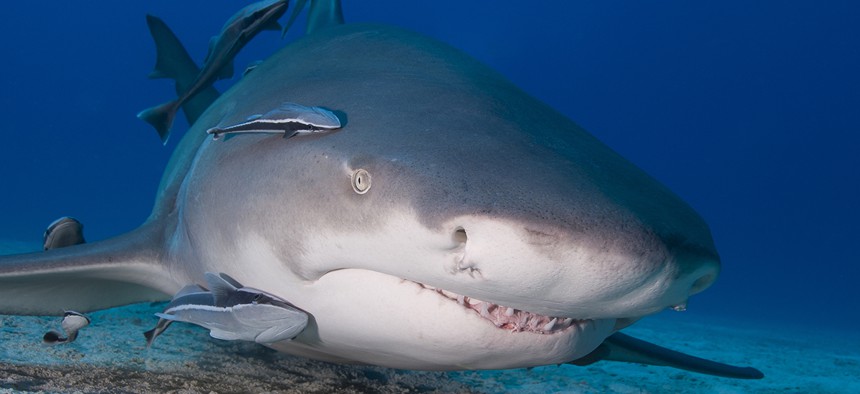Navy’s Future Submarines May Go to Sea with Robot Remoras

VisionDive/Shutterstock.com
The sucker-headed fish are drawing attention as the fleet imagines ways to bring drones to the undersea domain.
When Rear Adm. Michael Jabaley imagines the attack submarines of the future and how they’ll team with underwater drones, he pictures sharks — and the remora fish attached to them.
The remora, which uses its suction-cup head to catch rides with large marine animals, suggests there’s a new and better way for subs and unmanned undersea vehicles to work together, said Jabaley, the U.S. Navy’s program executive officer for submarines
“Everything we have done to date has been through repurposing of an existing interface between the submarine and the ocean,” he said at a recent talk at the Center for Strategic and International Studies. “We’ve used torpedo tubes, we’ve used signal ejectors, we’ve used the dry-deck shelter, we’ve even used the trash ejector as a way to get the payload out of the submarine and deploy it.”
The admiral is looking ahead to the class of attack submarines that will follow the Virginias, which were designed in the 1990s and whose first ship launched in 2003. The next class of SSNs would be redesigned “from the ground up [and] would seamlessly integrate UUVs,” possibly in a biomimetic fashion.
“The dream, actually, would be if you’ve ever seen a remora,” Jabaley said. “Those are the little fish that suck onto the big fish and go along, and seem to not affect the big fish at all, ride in the stream, and then when it’s time for them to go off and do something, they do, and then they come back. That’s forward-thinking. It’s different from anything we’ve done.”
The Navy’s current, jury-rigged way of using of UUVs is part of a broader trend within the military, as services circumvent the oft-protracted acquisition process by finding creative new uses for systems they already have. But it’s also a specific function of the United States' asymmetric advantage at sea, according to Peter Singer, an author and strategist at the New America Foundation.
“We’re just now scratching the surface in terms of what kind of robotics we can use, how many we might have, and how we can use them — in all the different domains, but particularly in undersea weapons,” Singer said. “One of the forcing mechanisms that leads to change is actual battlefield use. You can see that in the Middle East: Unfortunately, the challenge of IEDs is what had a forcing mechanism for ground robotics.”
The Navy, thus far, has been fortunate not to face that “forcing function of battle,” he said.
There’s also another decade and half of Virginia-class SSNs still to be built, not to mention the nuclear missile-launching Ohio-class replacements scheduled to start procurement in fiscal year 2021. When the Navy does start thinking seriously about designing and generating the requirements for the next class of attack submarines, UUV integration will be just one of a myriad technological innovations, biomimetic or otherwise.
“If you look in nature, there are no fish designed around being long tubes with propellers behind them,” Singer said. “But you can also do things that you don’t even see in nature. You could litter the sea floor with batteries … and robotics would be able to go and charge on them.”
For his part, Jabaley is also thinking about ways to do away with rotating propellors, which produce sound that can give away a sub’s location.
“Those are very far-off, very out-there type of ideas, but things we need to be thinking about to get there eventually,” the two-star said. “It will take a while to get there, but since I’m dreaming, that would be my technological leap.”
NEXT STORY: Watchdog: DOD's infrastructure push needs scope



